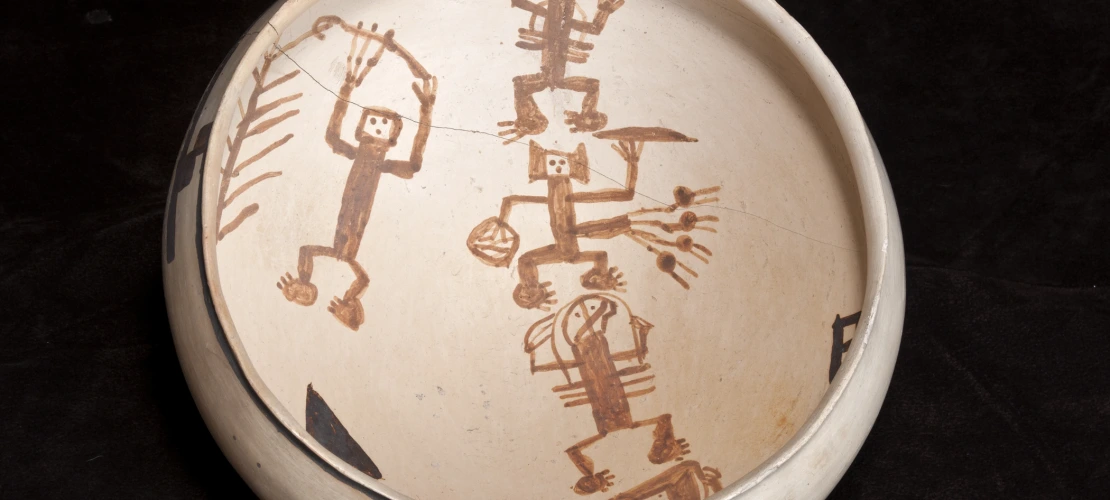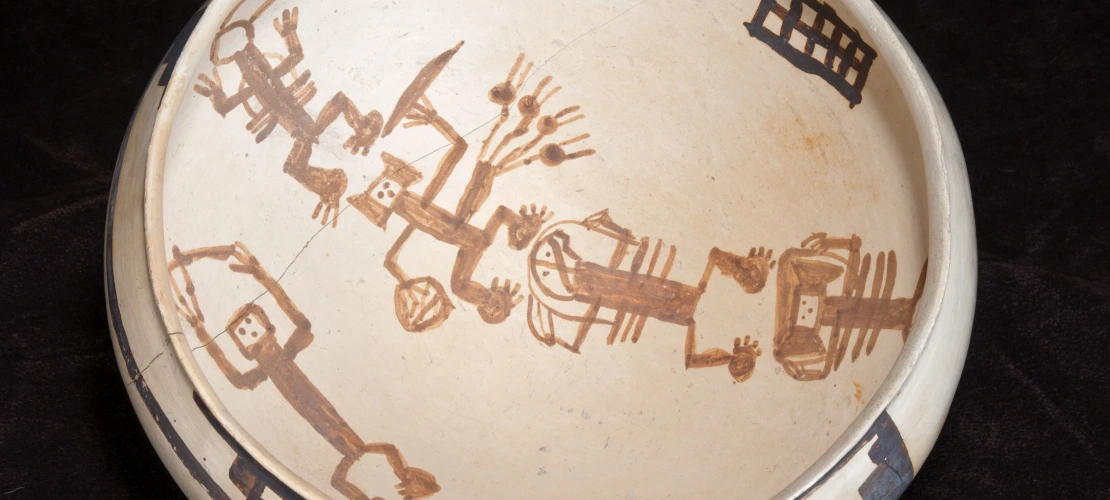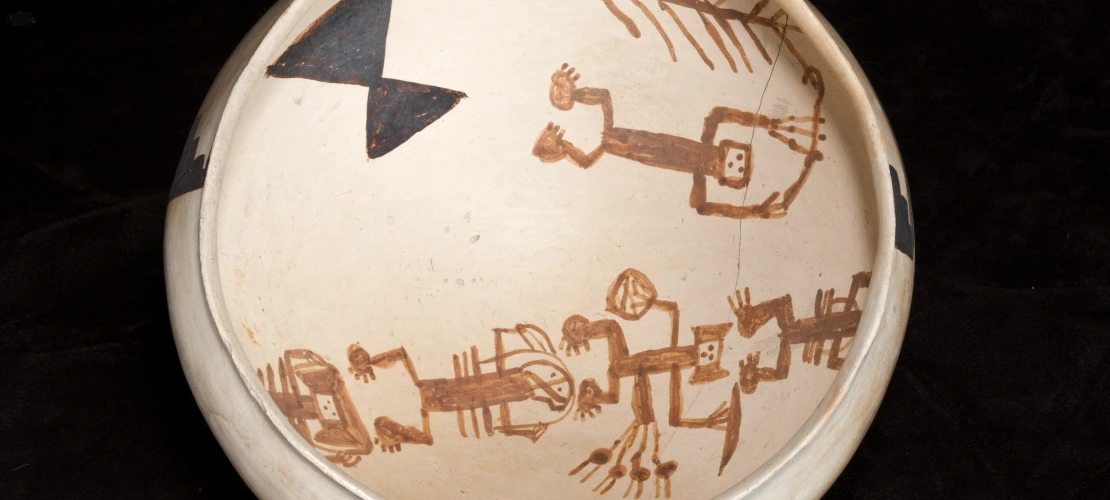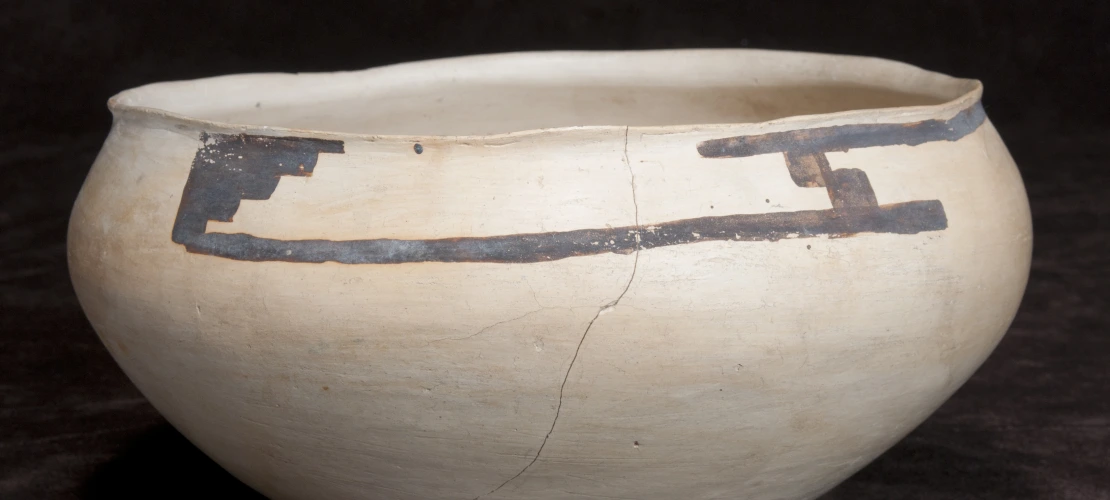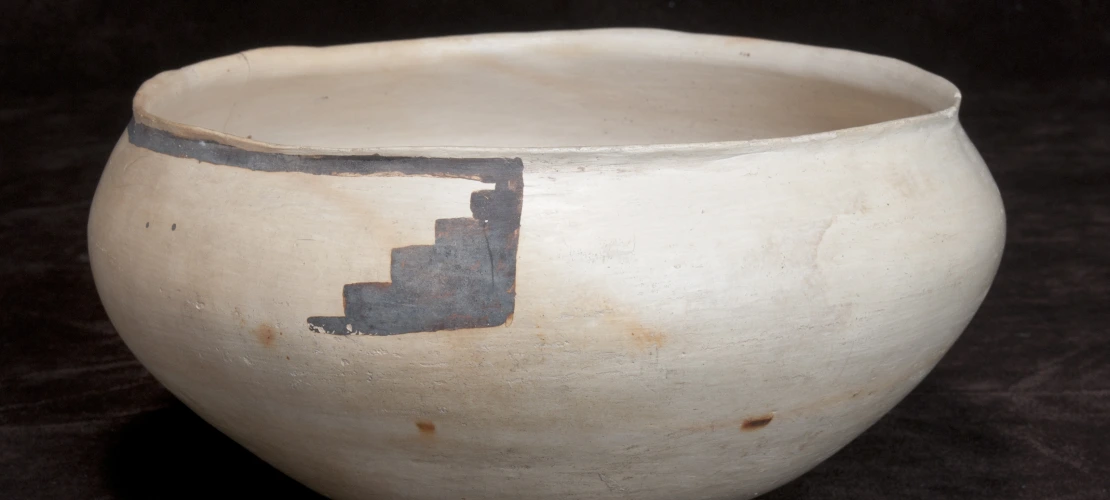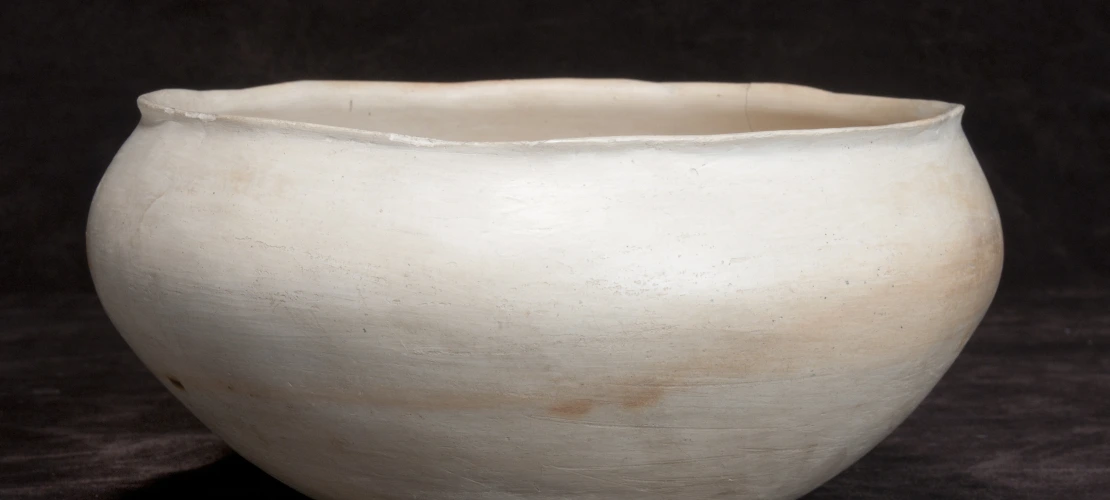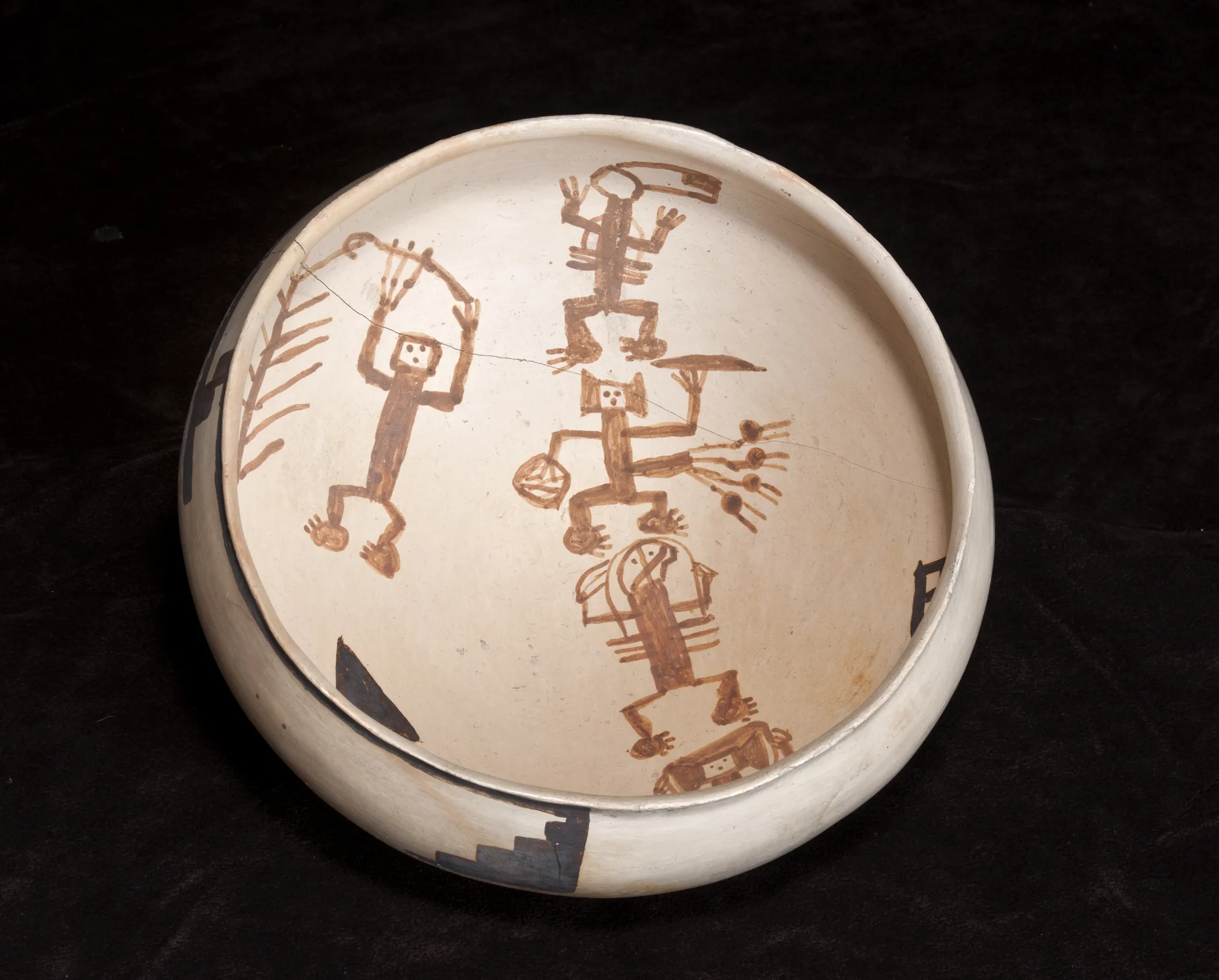
See more images in the slideshow below
Sikyatki Polychrome Bowl, ca. 1425–1629 C.E. Ancestral Hopi Hopi Indian Reservation, Northeast Arizona. Height: 4.9 in (12.5 cm), Maximum diameter: 10.1 in (25.7 cm). Dr. Joshua Miller Collection, Gift of the Arizona Archaeological and Historical Society, 1917 (ASM Catalog No. 4141). Photos by Alanah Tupponce.
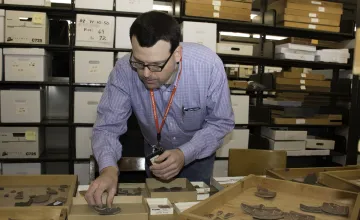
Text by Patrick D. Lyons, Director. August 2013
This bowl depicts five human-like figures, two abstract symbols, and what appears to be a plant of some kind. Two of the human-like figures are identifiable as females based on their “butterfly whorl” hairstyle (poli’ini in Hopi), which was traditionally worn by unmarried Hopi women. Based on similar painted designs on other ancient pottery vessels and images pecked into sandstone cliffs, this hairstyle was present in the U.S. Southwest as early as 200 C.E.
Kelley Hays-Gilpin and Jane Hill have linked this distinctive way of dressing the hair to an ancient ideological system they call the “Flower World.” Flower World imagery reflects the concept of a brilliantly colorful, flowery afterlife; the association of hearts, souls, fire, blood, strength, and spirituality with flowers; and the notion that this world and the spirit world can affect each other through flower world imagery in speech, song, and the arts.
These religious ideas are shared by many native groups who speak Uto-Aztecan languages (such as the Hopi, the Akimel and Tohono O’odham, the Yoeme, and the Aztecs), as well as neighboring groups in the US Southwest and Mesoamerica. Important symbols of the Flower World include flowers, butterflies, colorful birds, and rainbows. Hays-Gilpin suggests that butterfly whorls represent the reproductive potential of young women.
One of the figures not wearing butterfly whorls holds a crook (ngölöshoya; an object shaped like a walking cane), indicating that the painted scene is part of a ritual observance. Crooks used in the public portions of Hopi ceremonies are like badges of ritual office. Depictions of crooks in the rock art of the Four Corners region date back as early as 500 C.E. and wooden crooks like those used by the Hopi today have been recovered from archaeological sites dating to the 600s C.E.
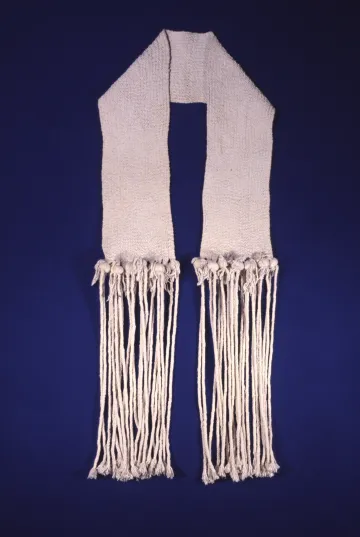
Hopi wedding sash, ASM Catalog No. 19188
The “rain sash” (or wedding sash; wukokwewa, literally “big belt”) worn by one of the female figures identifies the ritual observance as a katsina ceremony and the human-like figures as katsinam rather than living people. This is because an unmarried Hopi woman, wearing butterfly whorls, would not wear this item of clothing.
Traditionally, the Hopi bride changes her hairstyle to that of a married woman (torikuyi; pigtails on the sides of the head, wrapped with string) near the beginning of the sequence of wedding rituals that culminate many days or weeks later with her being presented her wedding clothes, including the rain sash. Female katsinam wear rain sashes even if they are unmarried “maidens” (maamánt, plural; maana, singular). The rain sash is distinctive because of its long fringe and the “flower balls” (sipölo) that adorn it. The earliest evidence of this garment comes from murals in kivas (subterranean ceremonial structures) at the ancestral Hopi village of Awat’ovi dating in the 1400s C.E.
Katsinam are Hopi ancestor spirits who return to this world between the Winter and Summer solstices to ensure the productivity of crops and to teach the living how to behave appropriately. Because three of the figures painted on the bowl carry burden baskets (hòo’apu; ho’apu, singular) with tumplines (ngaat’a; ngat’a, singular), they can be identified as Ogre katsinam (Sooso’yokt; So’yoko, singular). This group visits the Hopi villages during Powamuya, in February. They urge boys to be good hunters and girls to be good grinders of corn.
The plant depiction and the abstract designs—a solid hourglass shape (formed by two triangles that meet at their apices) and a grid—can be interpreted in the context of Ogre katsina ceremonies. The plant is likely a portion of a Douglas Fir (salavi), a tree associated with katsinam and especially the observances of Powamuya. The hourglass is an ancient puebloan symbol associated with war, hunting, and destructive or dangerous forces.
Alexander Stephen reported that this hourglass symbol represents the hömsoma (literally, “hair tie”), the traditional Hopi man’s hairstyle (hair tied in a knot at the nape of the neck, forming a “club”) and that a vessel used to hold medicine water for the initiation of Hopi hunters was decorated with this motif. The grid is a simple way to represent the rows of kernels on an ear of corn. The hunting symbol and the corn motif recall the urgings of the Ogres, that Hopi children learn to be industrious lest they be carried off in the monsters’ burden baskets to be eaten.
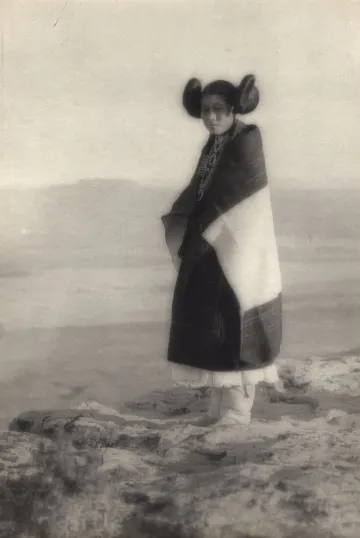
Girl wearing butterfly whorls, Walpi, First Mesa, Hopi Reservation, Arizona. Forman Hanna, photographer, c. 1920
ASM came to have this vessel in 1917 when the collection of Dr. Joshua Miller was purchased for the Museum by the Arizona Archaeological and Historical Society. Miller moved to Arizona in 1883. He soon became a collector of crafts produced by the tribes of the state and through this activity became concerned about their health and wellbeing. He also became president of the Arizona Antiquarian Association.
He eventually spent his summers providing free medical care to people on the Hopi Indian Reservation. Between 1890 and his death in 1901, Dr. Miller treated the great Hopi-Tewa potter Nampeyo for trachoma (an eye disease). He was sometimes given gifts by his patients, including Nampeyo. These objects, as well as materials he purchased or excavated, accumulated over the years and by the end of his life numbered more than 2,300 specimens. The entire collection was sold, by Miller’s widow, for $500. The money was raised largely through the efforts of former ASM Director (1915–1938) Byron Cummings.
This bowl is a specimen of Sikyatki Polychrome, a type in Jeddito Yellow Ware. This identification is based on its yellow color, the fine texture of the clay used to produce it, the vessel’s hardness (due to a high firing temperature made possible through the use of coal), the appearance of the paints used to decorate it, and its shape. Jeddito Yellow Ware was made by Hopi and ancestral Hopi groups between the 1300s and the late 1600s C.E.
The use of yellow as a background color marked a significant change in the Hopi ceramic tradition and is likely related to Flower World ideology, as yellow is the quintessential color associated with flowers by Uto-Aztecan speakers. Hopis associate yellow with the northwest, where the passage between this world and the spirit world (the sípàapuni) is said to be located (in the Grand Canyon). Hopi potters revived yellow pottery during the late 1800s and continue to produce it today.
I chose this vessel because, although there are many examples of ancient katsina depictions, it is very difficult in most cases to determine the particular katsina or ceremony that is represented. Dating as early as 1425, this bowl likely represents the earliest and richest prehispanic depiction of Hopi Ogre katsinam available for study. Objects like this highlight the continuity of the region’s cultures over many centuries.
Hover your mouse over the image to halt the slideshow
Sikyatki Polychrome Bowl, ca. 1425–1629 C.E. Ancestral Hopi Hopi Indian Reservation, Northeast Arizona. Height: 4.9 in (12.5 cm), Maximum diameter: 10.1 in (25.7 cm). Dr. Joshua Miller Collection, Gift of the Arizona Archaeological and Historical Society, 1917 (ASM Catalog No. 4141). Photos by Alanah Tupponce.
Links
Rainmakers from the Gods, an online exhibition from the Peabody Museum of Archaeology and Ethnology at Harvard University, provides an excellent introduction to the Katsina religion, its calendar and ceremonies, including 36 annotated illustrations of katsina dolls.
Ancient Jeddito Yellow Ware bowl with an image of the Hopi Stick-Swallower (Mòmtsit) ceremony from the Anthropology Department of the Smithsonian National Museum of Natural History,
Drawings of Hopi Ogre katsinam: Awatobi Soyok Taka and Awatobi Soyok Wüqti and Soyok Wüqti from the website of Dr. Rodney Frey, University of Idaho.
1893 photograph of katsinam associated with the Powamu Ceremony (note the rain or wedding sash on the katsina in the middle of the image) from the Singing Desert website.
1900 photograph of a Hopi woman dressing hair of unmarried girl from the National Archives.
Early 20th century photographs of Hopi girls with butterfly whorl hair styles by Adam Clark Vroman from the collections of the California Museum of Photography: Portrait One and Portrait Two.
Early 20th century photographs of Hopi girls with butterfly whorl hair styles by Adam Clark Vroman from collections of the Natural History Museum of Los Angeles County: Portrait One, Portrait Two, Portrait Three, Portrait Four, Portrait Five, Portrait Six.
Traditional Hopi hairstyle for women from the First People website (child friendly site about Native Americans and members of the First Nations).
Nampeyo and her pottery on the ASM website.
References
Hopi Language
Hill, Kenneth C., Emory Sekaquaptewa, Mary E. Black, Ekkehart Malotki, and Michael Lomatuway'ma (editors)
- 1998 Hopi Dictionary (Hopìikwa Lavàytutuveni): A Hopi-English Dictionary of the Third Mesa Dialect. University of Arizona Press, Tucson.
Hopi and Zuni Katsinam
Adams, E. Charles
- 1991 The Origin and Development of the Pueblo Katsina Cult. University of Arizona Press, Tucson.
Colton, Harold S.
- 1989 Hopi Kachina Dolls, With a Key to Their Identification. Reprinted. Revised edition. University of New Mexico Press, Albuquerque. Originally published 1959.
Fewkes, Jesse W.
- 1903 Hopi Katcinas Drawn by Native Artists. In Twenty-First Annual Report of the Bureau of American Ethnology for the Years 1899-1900, pp.3-360. Government Printing Office, Washington D.C.
Secakuku, Alph H.
- 1995 Following the Sun and Moon: Hopi Kachina Tradition. Northland Publishing, Flagstaff.
Wright, Barton
- 1977 Hopi Kachinas: The Complete Guide to Collecting Kachina Dolls. Northland, Flagstaff.
- 1979 Hopi Material Culture: Artifacts Gathered by H. R. Voth in the Fred Harvey Collection. Northland Press, Flagstaff and the Heard Museum, Phoenix.
- 1994 Clowns of the Hopi: Tradition Keepers and Delight Makers. Northland, Flagstaff.
Wright, Barton, and Cliff Bahnimptewa
- 1994 Kachinas: A Hopi Artist's Documentary. Northland, Flagstaff.
Wright, Barton, and Duane Dishta
- 1985 Kachinas of the Zuni. Northland Press, Flagstaff.
Hopi Ogre Katsinam
Kealiinohomoku, Joann W.
- 1980 The Drama of the Hopi Ogres. In Southwestern Indian Ritual Drama, edited by Charlotte J. Frisbie, pp. 37-69. School of American Research Press, Santa Fe, and University of New Mexico Press, Albuquerque.
Parsons, Elsie Clews
- 1925 A Pueblo Indian Journal, 1920-1921. Memoirs of the American Anthropological Association No. 32. American Anthropological Association, Menasha, Wisconsin.
Parsons, Elsie Clews (editor)
- 1936 Hopi Journal of Alexander M. Stephen. 2 vols. Columbia University Contributions to Anthropology No. 23. Columbia University Press, New York.
Titiev, Mischa
- 1992 Old Oraibi: A Study of the Hopi Indians of Third Mesa. University of New Mexico Press, Albuquerque. Originally published 1944, Papers of the Peabody Museum of American Archaeology and Ethnology, Vol. 22(1). Harvard University, Cambridge.
The Uto-Aztecan Flower World
Hays-Gilpin, Kelley Ann, and Jane H. Hill
- 1999 The Flower World in Material Culture: An Iconographic Complex in the Southwest and Mesoamerica. Journal of Anthropological Research 55(1):1-37.
- 2000 The Flower World in Prehistoric Southwest Material Culture. In The Archaeology of Regional Interaction: Religion, Warfare, and Exchange Across the American Southwest and Beyond, edited by Michelle Hegmon, pp. 411-428. University Press of Colorado, Boulder.
Hays-Gilpin, Kelley Ann, and Emory Sekaquaptewa
- 2006 Sìitàlpuva: Through the Land Brightened with Flowers. Plateau: The Land and People of the Colorado Plateau 3(1):12-25
Hill, Jane H.
- 1992 The Flower World of Old Uto-Aztecan. Journal of Anthropological Research 48(2):117-144.
Traditional Hopi Wedding Ceremonies and Associated Garments
Beaglehole, Ernest, and Pearl Beaglehole
- 1976 Hopi of the Second Mesa. Reprinted. Kraus Reprint, Millwood, New York. Originally published 1935, Memoirs of the American Anthropological Association No. 44.
Colton, Mary-Russell F., and Edmund Nequatewa
- 1933 Hopi Courtship and Marriage: Second Mesa. Museum of Northern Arizona Museum Notes 5(9):41-54.
Kent, Kate Peck
- 1940 The Braiding of a Hopi Wedding Sash. Plateau 12(3):46-52.
- 1983 Prehistoric Textiles of the Southwest. School of American Research Press, Santa Fe, and University of New Mexico Press, Albuquerque.
- 1983 Pueblo Indian Textiles: A Living Tradition. School of American Research Press, Santa Fe.
Page, Susanne, and Jake Page
- 1982 Hopi. Abradale Press, New York.
Parsons, Elsie Clews
- 1996 Pueblo Indian Religion. 2 vols. Reprinted. University of Nebraska Press, Lincoln. Originally published 1939, University of Chicago Press, Chicago.
Parsons, Elsie Clews (editor)
- 1936 Hopi Journal of Alexander M. Stephen. 2 vols. Columbia University Contributions to Anthropology No. 23. Columbia University Press, New York.
Titiev, Mischa
- 1992 Old Oraibi: A Study of the Hopi Indians of Third Mesa. University of New Mexico Press, Albuquerque. Originally published 1944, Papers of the Peabody Museum of American Archaeology and Ethnology, Vol. 22(1). Harvard University, Cambridge.
Udall, Louise
- 1969 Me and Mine: The Life Story of Helen Sekaquaptewa. University of Arizona Press, Tucson.
Voth, H. R.
- 1900 Oraibi Marriage Customs. American Anthropologist 2(2):238-246.
Webb, William, and Robert A. Weinstein
- 1987 Dwellers at the Source: Southwestern Indian Photographs of A. C. Vroman, 1895-1904. University of New Mexico Press, Albuquerque
Webster, Laurie D.
- 2007 Ritual Costuming at Pottery Mound: The Pottery Mound Textiles in Regional Perspective. In New Perspectives on Pottery Mound Pueblo, edited by Polly Schaafsma, pp. 167-206. University of New Mexico Press, Albuquerque.
Wright, Barton
- 1979 Hopi Material Culture: Artifacts Gathered by H. R. Voth in the Fred Harvey Collection. Northland Press, Flagstaff and the Heard Museum, Phoenix.
Katsina Imagery on Ancient and Historic Pottery
Adams, E. Charles
- 1991 The Origin and Development of the Pueblo Katsina Cult. University of Arizona Press, Tucson.
Ferg, Alan
- 1982 14th Century Kachina Depictions on Ceramics. In Collected Papers in Honor of John W. Runyan. Papers of the Archaeological Society of New Mexico No. 7, edited by Gerald X. Fitzgerald, pp. 13-29. Albuquerque Archaeological Society Press, Albuquerque.
Fewkes, Jesse W.
- 1898 Archeological Expedition to Arizona in 1895. In Seventeenth Annual Report of the Bureau of American Ethnology for the Years 1895-1896, Part 2, pp.519-752. Government Printing Office, Washington, D.C.
- 1919 Designs on Prehistoric Hopi Pottery. In Thirty-Third Annual Report of the Bureau of American Ethnology for the Years 1911-1912 , pp.207-284. Government Printing Office, Washington D.C.
Hays, Kelley Ann
- 1989 Katsina Depictions on Homol’ovi Ceramics: Toward a Fourteenth-Century Pueblo Iconography. Kiva 54(3):297-311.
- 1994 Kachina Depictions on Prehistoric Pueblo Pottery. In Kachinas in the Pueblo World, edited by Polly Schaafsma, pp. 47-62. University of New Mexico Press, Albuquerque.
Hays-Gilpin, Kelley Ann
- 2004 “Maidens” and Flute Players in the Southwest. In Ambiguous Images: Gender and Rock Art, by Kelley Ann Hays-Gilpin, pp. 127-146. AltaMira Press, Walnut Creek, California.
- 2006 Icons and Ethnicity: Hopi Painted Pottery and Murals. In Religion in the Prehispanic Southwest, edited by Christine S. VanPool, Todd L. VanPool, and David A. Phillips, Jr., pp. 67- 80. AltaMira Press, Lanham, Maryland.
Martin, Paul S. and Elizabeth S. Willis
- 1940 Anasazi Painted Pottery in Field Museum of Natural History. Anthropology Memoirs, vol. 5. Field Museum of Natural History, Chicago.
Wade, Edwin L., and Lea S. McChesney
- 1980 America’s Great Lost Expedition: The Thomas Keam Collection of Hopi Pottery from the Second Hemenway Expedition, 1890-1894. The Heard Museum, Phoenix.
- 1981 Historic Hopi Ceramics: The Thomas V. Keam Collection of the Peabody Museum of Archaeology and Ethnology, Harvard University. Peabody Museum Press, Cambridge.
Non-Katsina Hopi Ceremonies Depicted on Ancient Pottery
Fewkes, Jesse W.
- 1898 Archeological Expedition to Arizona in 1895. In Seventeenth Annual Report of the Bureau of American Ethnology for the Years 1895-1896, Part 2, pp.519-752. Government Printing Office, Washington, D.C.
- 1919 Designs on Prehistoric Hopi Pottery. In Thirty-Third Annual Report of the Bureau of American Ethnology for the Years 1911-1912 , pp.207-284. Government Printing Office, Washington D.C.
Parsons, Elsie Clews
- 1940 A Pre-Spanish Record of Hopi Ceremonies. American Anthropologist 42(3, part 1):541-542.
Patterson, Alex
- 1994 Hopi Pottery Symbols. Johnson Books, Boulder.
Jeddito Yellow Ware (including coal-firing of pottery)
Bartlett, Katharine
- 1935 Prehistoric Mining in the Southwest. Museum Notes 7(10):41-44.
Bishop, Ronald L., Veletta Canouts, Suzanne P. De Atley, Alfred Qöyawayma, and C. W. Aikins
- 1988 The Formation of Ceramic Analytical Groups: Hopi Pottery Production and Exchange, A.C. 1300-1600. Journal of Field Archaeology 15(3):317-337.
Brew, J. O., and John T. Hack
- 1939 Prehistoric Use of Coal by Indians of Northern Arizona. Plateau 12(1):8-14.
Colton, Harold S.
- 1936 Hopi Coal Mines. Museum Notes 8(12):59-61.
- 1939 Primitive Pottery Firing Methods. Museum Notes 11(10):63-66.
- 1951 Hopi Pottery Firing Temperatures. Plateau 24(2):73-76.
- 1953 Potsherds: An Introduction to the Study of Prehistoric Southwestern Ceramics and Their Use in Historic Reconstruction. Museum of Northern Arizona Bulletin No. 25. Northern Arizona Society of Science and Art, Flagstaff.
Colton, Harold S. (editor)
- 1956 Pottery Types of the Southwest. Museum of Northern Arizona Ceramic Series No. 3C. Northern Arizona Society of Science and Art, Flagstaff.
Hack, John T.
- 1942 Prehistoric Coal Mining in the Jeddito Valley, Arizona. Papers of the Peabody Museum of American Archaeology and Ethnology, Vol. 35(2). Reports of the Awatovi Expedition, Peabody Museum, Harvard University No. 2. Harvard University, Cambridge.
Hays, Kelley Ann
- 1991 Ceramics. In Homol'ovi II: Archaeology of an Ancestral Hopi Village, Arizona, edited by E. Charles Adams and Kelley Ann Hays, pp. 23-48. Anthropological Papers of the University of Arizona No. 55. The University of Arizona Press, Tucson.
Hays, Kelley Ann, and Diane D. Dittemore
- 1990 Seven Centuries of Hopi Pottery: Yellow Ware from Arizona State Museum Collections. American Indian Art 15(3):56-65.
Hays-Gilpin, Kelley Ann, and Steven A. LeBlanc
- 2007 Sikyatki Style in Regional Context. In New Perspectives on Pottery Mound Pueblo, edited by Polly Schaafsma, pp. 109-136. University of New Mexico Press, Albuquerque.
Hodge, Frederick W.
- 1904 Hopi Pottery Fired with Coal. American Anthropologist 6(4):581-582.
LeBlanc, Steven A., and Lucia R. Henderson
- 2009 Symbols in Clay: Seeking Artists’ Identities in Hopi Yellow Ware Bowls. Papers of the Peabody Museum of Archaeology and Ethnology, Vol. 84. Harvard University, Cambridge.
Lyons, Patrick D.
- 2003 Ancestral Hopi Migrations. Anthropological Papers of the University of Arizona No. 68. University of Arizona Press, Tucson.
Smith, Watson
- 1971 Painted Ceramics of the Western Mound at Awatovi. Papers of the Peabody Museum of Archaeology and Ethnology, Vol. 38. Harvard University, Cambridge.
Hopi Material Culture
Geertz, Armin W.
- 1987 Hopi Indian Altar Iconography. Iconography of Religion X(5). Institute of Religious Iconography, State University of Groningen. E. J. Brill, Leiden, The Netherlands.
Hough, Walter
- 1918 The Hopi Indian Collection in the United States National Museum. Proceedings of the United States National Museum 54(2253): 235-296.
Lyons, Patrick D.
- 2003 Hopi Ethnoarchaeology in Relation to the Hohokam. In Yep Hisat Hoopoq'yaqam Yeesiwa (Hopi Ancestors Were Once Here): Hopi-Hohokam Cultural Affiliation Study, compiled by T. J. Ferguson, pp. 123-163. Hopi Cultural Preservation Office, The Hopi Tribe, Kykotsmovi, Arizona.
Wright, Barton
- 1979 Hopi Material Culture: Artifacts Gathered by H. R. Voth in the Fred Harvey Collection. Northland Press, Flagstaff and the Heard Museum, Phoenix.
Ancestral Hopi Rock Art
Cole, Sally J.
- 1992 Katsina Iconography in Homol'ovi Rock Art, Central Little Colorado River Valley, Arizona. The Arizona Archaeologist No. 25. Arizona Archaeological Society, Phoenix.
- 1994 Roots of Anasazi and Pueblo Imagery in Basketmaker II Rock Art and Material Culture. Kiva 60(2):289-311.
Hays-Gilpin, Kelley Ann
- 2004 “Maidens” and Flute Players in the Southwest. In Ambiguous Images: Gender and Rock Art, by Kelley Ann Hays-Gilpin, pp. 127-146. AltaMira Press, Walnut Creek, California.
Malotki, Ekkehart
- 2007 The Rock Art of Arizona: Art for Life’s Sake. Kiva Publishing, Walnut, California.
McCreery, Patricia, and Ekkehart Malotki
- 1994 Tapamveni: The Rock Art Galleries of the Petrified Forest and Beyond. Petrified Forest Museum Association, Petrified Forest, Arizona.
Patterson, Alex
- 1992 A Field Guide to Rock Art Symbols of the Greater Southwest. Johnson Books, Boulder.
Schaafsma, Polly
- 1980 Indian Rock Art of the Southwest. School of American Research, Santa Fe, and University of New Mexico Press, Albuquerque.
- 2000 Warrior, Shield, and Star: Imagery and Ideology of Pueblo Warfare. Western Edge Press, Santa Fe.
Ancestral Pueblo Kiva Murals
Smith, Watson
- 1952 Kiva Mural Decorations at Awatovi and Kawaika-a with a Survey of Other Wall Paintings in the Pueblo Southwest. Papers of the Peabody Museum of American Archaeology and Ethnology, Vol. 37. Harvard University, Cambridge.
Webster, Laurie D.
- 2007 Ritual Costuming at Pottery Mound: The Pottery Mound Textiles in Regional Perspective. In New Perspectives on Pottery Mound Pueblo, edited by Polly Schaafsma, pp. 167-206. University of New Mexico Press, Albuquerque.
Dr. Joshua Miller
Mooney, James
- 1901 Dr Joshua Miller. American Anthropologist 3(3):592.
Wilcox, David R.
- 1987 Frank Midvale’s Investigation of the Site of La Cuidad. Anthropological Field Studies No. 19. Office of Cultural Resource Management, Department of Anthropology, Arizona State University, Tempe.
- 1993 Pueblo Grande in the Early Twentieth Century. In Archaeology of the Pueblo Grande Platform Mound and Surrounding Features, Volume 1: Introduction to the Archival Project and History of Archaeological Research, edited by Christian E. Downum and Todd W. Bostwick, pp. 73-96. Pueblo Grande Museum Anthropological Papers No. 1. Pueblo Grande Museum, Phoenix.
- 2005 Creating a Firm Foundation: The Early Years of the Arizona State Museum. Journal of the Southwest 47(3):375-410.
Nampeyo
Blair, Mary Ellen, and Laurence Blair
- 1999 The Legacy of a Master Potter: Nampeyo and Her Descendants. Treasure Chest Books, Tucson.
Kramer, Barbara
- 1996 Nampeyo and Her Pottery. University of New Mexico Press, Albuquerque.






